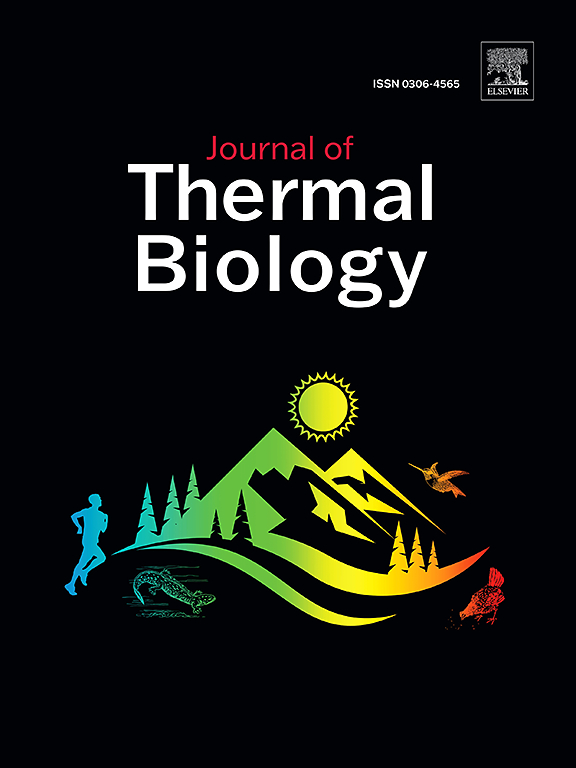Does body cooling facilitated by bedding compared to control condition improve sleep among adults (18–64 years old)? A systematic review and meta-analysis
IF 2.9
2区 生物学
Q2 BIOLOGY
引用次数: 0
Abstract
Introduction
The relationship between blood distribution, body temperature, and sleep/wakefulness states is still unclear. The aim of the present study is to systematically review the potential beneficial effects of bedding strategies (e.g., mattress, mattress topper or pillow) on body cooling and night-time sleep.
Material & methods
This systematic review with meta-analysis searched PubMed, ScienceDirect and Web of Science, from inception until March 4, 2024. We included randomized controlled trials aiming to investigate any type of bedding that induced body cooling compared to habitual sleep environment on sleep parameters in healthy adults. Two reviewers independently extracted data, appraised risk of bias by Cochrane tool, and estimated the mean differences between groups with 95% confidence interval. Meta-analyses and proportional meta-analyses were performed depending on the type of variable. The certainty of evidence was assessed using the Grades of Recommendation, Assessment, Development and Evaluation system.
Results
From 3454 articles screened, 9 studies met the inclusion criteria. Overall, with the certainty of the evidence ranging from very low to low we found no differences between groups on sleep onset latency, sleep efficiency, sleep proportion spent in each sleep stage (i.e. N1, N2, N3 and REM), wake after sleep onset, and total sleep time. Results could be interpreted with caution due to high heterogeneity in the estimated effects.
Conclusion
With uncertainty of evidence, that ranged from very low to low, different bedding strategies had no effects on night-time sleep characteristics; however, the studies included into the qualitative synthesis suggested an effect of different bedding strategies on body cooling (i.e., lower core body temperature, p < 0.05) from an acute perspective. Future studies on various forms of bedding interventions susceptible to favour and maintain sleep through a positive body thermal effect are highly warranted.
Prospero registration
CRD42021275369.
在成年人(18-64岁)中,与对照条件相比,被褥促进身体降温是否能改善睡眠?系统回顾和荟萃分析。
血液分布、体温和睡眠/觉醒状态之间的关系尚不清楚。本研究的目的是系统地回顾床上用品(例如,床垫,床垫顶部或枕头)对身体降温和夜间睡眠的潜在有益影响。材料与方法:本系统综述与荟萃分析检索了PubMed、ScienceDirect和Web of Science,检索时间从研究开始到2024年3月4日。我们纳入了随机对照试验,旨在调查任何类型的床上用品对健康成年人睡眠参数的影响,这些床上用品与习惯睡眠环境相比会导致身体降温。两位审稿人独立提取资料,通过Cochrane工具评估偏倚风险,并以95%置信区间估计组间平均差异。根据变量的类型进行meta分析和比例meta分析。使用推荐、评估、发展和评估等级系统评估证据的确定性。结果:从筛选的3454篇文章中,有9篇研究符合纳入标准。总体而言,由于证据的确定性从非常低到很低,我们发现各组之间在睡眠开始潜伏期、睡眠效率、每个睡眠阶段(即N1、N2、N3和REM)的睡眠比例、睡眠开始后的觉醒和总睡眠时间方面没有差异。由于估计效果的高度异质性,结果可能被谨慎解释。结论:在证据不确定的情况下,不同的床上用品策略对夜间睡眠特征的影响范围从非常低到低;然而,纳入定性综合的研究表明,不同的床上策略对身体冷却(即降低核心体温)有影响,p Prospero注册:CRD42021275369。
本文章由计算机程序翻译,如有差异,请以英文原文为准。
求助全文
约1分钟内获得全文
求助全文
来源期刊

Journal of thermal biology
生物-动物学
CiteScore
5.30
自引率
7.40%
发文量
196
审稿时长
14.5 weeks
期刊介绍:
The Journal of Thermal Biology publishes articles that advance our knowledge on the ways and mechanisms through which temperature affects man and animals. This includes studies of their responses to these effects and on the ecological consequences. Directly relevant to this theme are:
• The mechanisms of thermal limitation, heat and cold injury, and the resistance of organisms to extremes of temperature
• The mechanisms involved in acclimation, acclimatization and evolutionary adaptation to temperature
• Mechanisms underlying the patterns of hibernation, torpor, dormancy, aestivation and diapause
• Effects of temperature on reproduction and development, growth, ageing and life-span
• Studies on modelling heat transfer between organisms and their environment
• The contributions of temperature to effects of climate change on animal species and man
• Studies of conservation biology and physiology related to temperature
• Behavioural and physiological regulation of body temperature including its pathophysiology and fever
• Medical applications of hypo- and hyperthermia
Article types:
• Original articles
• Review articles
 求助内容:
求助内容: 应助结果提醒方式:
应助结果提醒方式:


